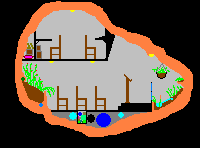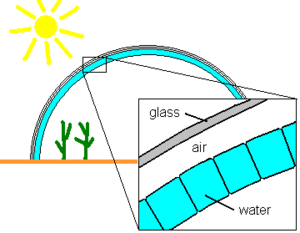Difference between revisions of "Storm shelter"
(→Energy Shields: Point out this only works for lower energy particles) |
|||
| Line 21: | Line 21: | ||
==Energy Shields== | ==Energy Shields== | ||
Strong localized magnetic fields have been shown to offer significant shielding from [[Ionizing Radiation]] (but not from [[Electromagnetic radiation]]). However during solar storms, the majority of the dangerous radiation is charged particles so a magnetic field would be useful. | Strong localized magnetic fields have been shown to offer significant shielding from [[Ionizing Radiation]] (but not from [[Electromagnetic radiation]]). However during solar storms, the majority of the dangerous radiation is charged particles so a magnetic field would be useful. | ||
| − | Such shields could be made portable for use on vehicles. | + | Such shields could be made portable for use on vehicles. The hope is that low and medium energy particles would be directed a few meters away from the vehicle. (High energy particles would punch thru the shield.) |
==References== | ==References== | ||
Latest revision as of 13:57, 17 September 2024

A storm shelter is a place where colonists can take refuge from a solar flare. The main settlement will be well shielded, so it in itself will be a storm shelter. However, manned rovers, railroad cars, airships and landers will need emergency shielding if a solar flare occurs.
Water is an ideal Radiation shield, and Robert Zubrin has suggested that a small volume in the centre of the Mars spaceships have the ship's water and food stored around it. Astronauts would crowd into to this small room for 2 to 5 hours to avoid the worst of the radiation. See pages 130 and 131 of "The Case for Mars".
Early warning system (solar radiation)
See the link in the title for more information. Early warning satellites are in place for the Earth, as a strong solar storm can be damaging to the technological and power infrastructure. Further, many observatories spread around Earth watch the sun at all times. These would also be used to warn Mars of a solar storm.[1] Explorers on Mars can expect several hours warning of a dangerous solar storm. (Note, for ~3 weeks a year, Earth is behind the Sun from the point of view of Martian explorers. At such times, they would have to watch the Sun for flares on their own.)
Explorers on Mars, would either not go far from their habitats when the sun is active, or make sure that they have some portable radiation shelter.
Physical Shields
Solar storms typically last for 2 to 5 hours, so a small volume where people can crowd together for a short time should be built which has very high radiation protection. Note that if the solar storm happens at local night, the planet itself will stop all of its radiation.
Ionizing radiation consists of moving, charged particles. A thin layer of metal will stop lower energy ions. (High energy ones might punch right thru.) Therefore, a storm shelter may include a layer of metal in addition to normal shielding.
High speed, particles are slowed by atoms with a low atomic mass. Therefore a good material for shielding is polyethylene, because it contains many hydrogen atoms, is light and can be made on Mars easily. Water, which is two-thirds hydrogen, is another shielding option.
Rock, regolith and concrete are all options if the equipment is available to arrange them in a suitable configuration. Blocks of soil mixed into a plastic matrix would be stronger and have better radiation protection than soil alone. Packed soil has a radiation halving-distance of 9.1 cm, so 55 cm of soil (six halving) would reduce the radiation by about 64 times. Two meters of soil is plenty for everyday living, but for a massive solar storm (which may come 0 to 2 times a decade) We would like to have 5 to 8 meters of protection. This suggests that a movie theatre style room in a tunnel below the base, would be ideal.
Energy Shields
Strong localized magnetic fields have been shown to offer significant shielding from Ionizing Radiation (but not from Electromagnetic radiation). However during solar storms, the majority of the dangerous radiation is charged particles so a magnetic field would be useful. Such shields could be made portable for use on vehicles. The hope is that low and medium energy particles would be directed a few meters away from the vehicle. (High energy particles would punch thru the shield.)
References
"The Case for Mars: The Plan to Settle the Red Planet and Why We Must", by Robert Zubrin, ISBN: 9-781451-608113.







